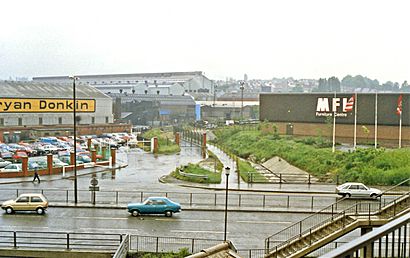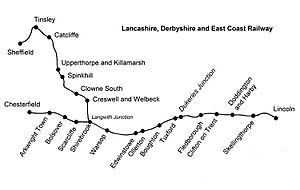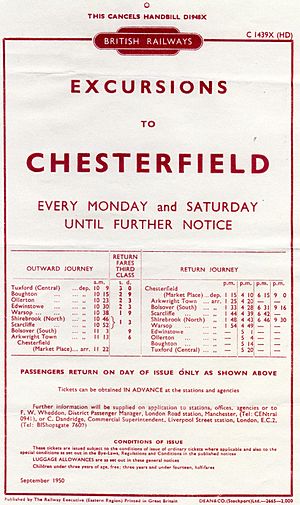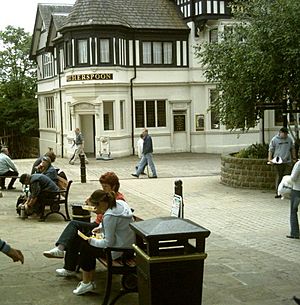Chesterfield Market Place railway station facts for kids
Quick facts for kids
Chesterfield Market Place
|
|
|---|---|

The site of the station in 1988
|
|
| Location | Chesterfield, Chesterfield England |
| Coordinates | 53°14′06″N 1°25′55″W / 53.2351°N 1.4319°W |
| Platforms | 4 |
| Other information | |
| Status | Disused |
| History | |
| Original company | LD&ECR |
| Pre-grouping | Great Central Railway |
| Post-grouping | LNER British Railways |
| Key dates | |
| 8 March 1897 | Opened as "Chesterfield" |
| 1 January 1907 | Renamed "Chesterfield Market Place" |
| 3 December 1951 | Closed to passengers |
| 4 March 1957 | Closed completely |
Chesterfield Market Place railway station was once a busy train station right in the middle of Chesterfield, a town in Derbyshire, England. It was an important transport hub for people and goods traveling east from the town.
Contents
Chesterfield's Three Train Stations
Chesterfield Market Place was the third and last train station built in the town. It was special because its trains went east, unlike the other two stations.
The other two stations were:
- Chesterfield Midland: This station is still open today and is simply called "Chesterfield". Its trains run north and south.
- Chesterfield Central: This station also had trains running north and south, but it closed down in 1963.
History of the Station
Opening and Early Days
The station first opened on 8 March 1897. It was called "Chesterfield" back then and was the main office for the LD&ECR company. On 1 January 1907, its name was changed to "Chesterfield Market Place".
The station was located on West Bars, right next to two old inns (like old hotels or pubs) called the White Horse and the Bird in Hand. To get more customers from the new railway, the owners of the White Horse decided to build a new hotel. This plan was approved in April 1898.
The new hotel was built in two stages. The first part was built where the Bird in Hand used to be. Once that was finished, the license and the landlord moved from the White Horse to the new part. Then, the second part of the hotel was built where the White Horse had stood. The hotel was named after the Duke of Portland, a very important person who owned much of the land the railway ran through. It officially opened in December 1899.
Station Design and Tracks
Chesterfield Market Place station was a large, impressive building with three floors and a long glass roof over the entrance. It looked very different from other stations on the line.
Inside, there was a big hall with a glass roof. This led to four curved platforms, arranged on two island platforms (like islands in the middle of the tracks). These were platforms 1 & 2, and 4 & 5. There was no platform 3; instead, that space was used for locomotives to change tracks. The nearby goods depot (where freight was handled) was the biggest covered area in Chesterfield at the time.
After leaving the station, the train line crossed Park Road over a brick bridge. It then went along an embankment (a raised area of land) and over the Boythorpe Viaduct. This viaduct crossed other railway lines. Further on, the line went over the Horns Bridge, a huge structure 63 feet high. It had seven brick arches and four metal spans, crossing over the Midland Railway, main roads, another railway, and the River Rother. From there, the line went uphill towards Duckmanton Tunnel and then to Arkwright Town station.
How Trains Operated
Until 1927, the station was also connected to the Chesterfield Tramway system. Trams ran from Brampton to Whittington. A special tram track was built near the station in Market Place. Old photos of the station even show the tramlines and overhead wires.
Passenger Train Services
Interestingly, Chesterfield Market Place station never had train services on Sundays.
In 1922, there were seven trains leaving the station on weekdays, with four extra trains on Saturdays. The weekday trains included:
- Two trains that stopped at every station all the way to Lincoln High Street (later called Lincoln Central). This journey took about an hour and a half.
- Three trains that stopped at every station to Mansfield Central, taking about 45 minutes.
- One train that stopped at every station to Bolsover (later called Bolsover South), which was a quick 12-minute trip.
On Saturdays, there were extra trains to Bolsover, Langwith Junction (later Shirebrook North), and Mansfield Central.
The railway company made sure that trains from other lines connected well at Langwith Junction. For example, at 10:44 AM, four trains would be waiting at Langwith Junction, ready to go to different places like Chesterfield Market Place, Lincoln, Sheffield Midland, and Mansfield.
More travel options were added in 1925. A train service from Nottingham Victoria, which used to end at Shirebrook South, was extended to Shirebrook North. However, this service was completely stopped in 1931.
During World War II, some train services were stopped. By 1945, trains to Mansfield Central ended. This left Chesterfield Market Place with only two trains to Lincoln and some shorter trips to Shirebrook North and Bolsover.
Station Closure
In August 1948, the station's unused tracks and space were used for a special event. It hosted the Stephenson Centenary Exhibition, showing old locomotives and train cars. As a final celebration, special trains ran to the coast just before the station closed to passengers on 3 December 1951.
The station closed to passengers because it was too expensive to fix and maintain the nearby Bolsover Tunnel and the Doe Lea Viaduct. Also, there wasn't enough train traffic to make it worthwhile. After passengers stopped using it, the tracks leading to the platforms were removed. The line to Arkwright Town was reduced to a single track and only used for one daily freight train from Staveley. This freight service ended on 4 March 1957, and the station closed completely.
After 1951, the station building was used by a paint and wallpaper company called Charles Credland Ltd until it was torn down. The tracks were removed in 1957 and 1958, and the bridge over Park Road was demolished using explosives.
| Preceding station | Disused railways | Following station | ||
|---|---|---|---|---|
| Terminus | Great Central Railway Lancashire, Derbyshire and East Coast Railway |
Arkwright Town Line and station closed |
||
What's There Now?
The station building was completely demolished in April 1973. The area has been redeveloped, and new buildings now stand where the station once was. The current building on the site is called Future Walk, which is the main finance office for the Post Office. If you look carefully at the bottom of the car park, you can still see a few signs of the old railway embankment.
Images for kids





